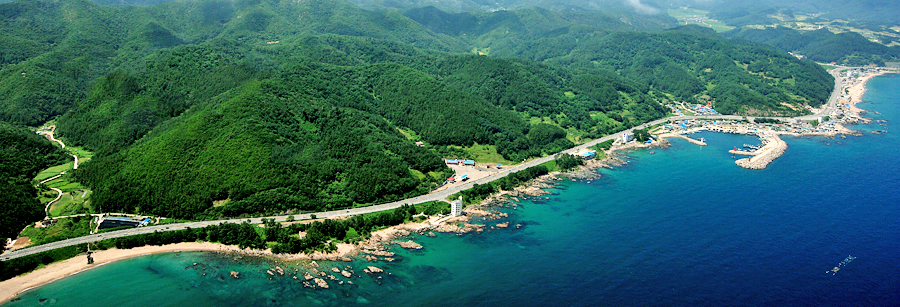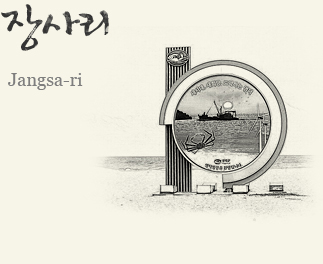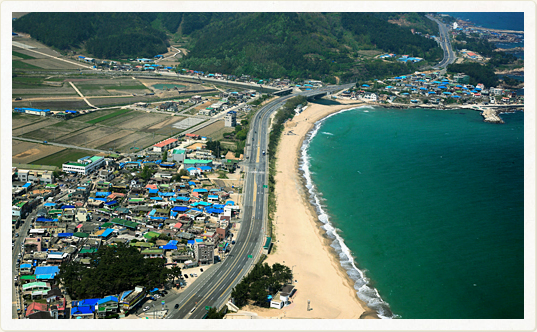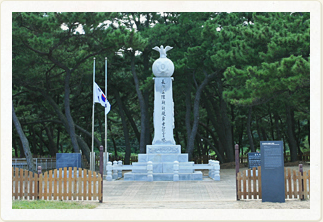

 > BlueRoad Story >
Story of Villages on BlueRoad
> BlueRoad Story >
Story of Villages on BlueRoad
Select each category and see the origin of villages in detail.



• Jangsa landing operation was carried out to undermine the alert of the enemy in advance for the success of the Inchon landing operation that began at 05:00 on September 15, 1950. This operation was intended to prevent the movement of the enemy into Incheon region as part of so-called "diversionary strategy" that has been executed in the Jangsa Beach, Jangsa-ri, Namjeong-myeon.
• The troops carrying out the landing operation was the first independent commando unit under the direct control of Army headquarters, which was organized urgently by 772 members in Daegu on August 27, 1950 and led by Lee Major General Myeong-heum in Milyang on August 27. After receiving the basic training in Milyang until 31 August, they moved to the Army Headquarters building in Busan again and received the basic commando unit training until September 11, and then were completely organized into the commando unit. The troops were organized into the regular Division for the sake of convenience, and were given the temporary ranking without the miliary serial number and class due to the characteristics of commando unit and prepared for the landing operation. The commando unit consisted of about 180 soldiers which correspond to 1 regiment troop, and was led by the colonel or lieutenant major, the temporary rank, under the system of Division. Ordinary soldiers were ordered to attach their rank arbitrarily.
• On September 10, 1950, the first commando unit completed the troop organization and was fully prepared to move out in accordance with the Army Headquarters' Order No. 174, and landed on the seaside of Jangsa-ri, Namjeong-myeon, disrupting the back area of the 2nd Corps of the North Korean Army led by Kim Moo-jeong, in order to prevent the enemy from noticing the Incheon Landing Operation. Meanwhile, the commando unit was also assigned the mission to slow down the movement of the enemy troop toward Incheon even if the enemy noticed the Incheon Landing Operation. Finally, the commando unit held a ceremony at the military training ground of the Army Headquarters in the afternoon on September 13 for combat and come aboard the LTS Munsanho, a 2,700-ton LST(Landing Ship Tank), at 14:00 at Busan Port and rushed to the coastal waters of Jangsa-ri, the site of landing operation.
• On September 10, 1950, the first commando unit made the Munsanho come alongside the sandy beach to complete the landing operation before the sunrise when the enemy guard is negligent. However, the Munsanho failed to come alongside the shoreline due to the lack of information about the coastal terrain and the tidal waves as high as 4 to 5m as typhoon 'Kezia‘ made landfall. Unfortuantely, Munsanho smashed onto the berm in the water. As a result, the landing operation attempt failed, and the commando unit trapped in the wrecked Munsanho came under the massive fire from the enemy.
• At that time, the 3rd Division stood face to face with the 5th Division of the enemy in the area around Yeongsang River, Pohang. The No. 101 Security Regiment of the enemy was deployed in the rear area of the 5th Division, controlling the coastal security and security of the occupied area. However, most elite troops of the enemy were deployed at this place due to the fierce battle in the area around Yeongsang River, Pohang, and only a small fraction of security forces were stationed at Yeokdeok and Jangsa-ri, the rear area.
• To thwart the attack of the landing troops, the enemy set up the pillbox along the seaside sandy beach, along with the mortars and direct-firing guns at the No. 271 highland called 'Bonghwangsan', at the hill behind Buheung-ri and at the No. 200 highland called 'Namsan', which posed the biggest threat to the landing troops.
• Although the amphibious vessel for the landing operation ran aground, the commando unit decided to press ahead with the landing operation. The special forces were selected to connect the amphibious vessel to the pine tree, using the long rope. Once the vessel was connected by the special forces, the 28th regiment attempted the amphibious landing first, and finally occupied the coastal area after many soldiers led by the Regiment Chief Lee Yeong-hoon were wounded or killed, thus covering the No. 29th, 37th, 32rd Regiments from the enemy fires and facilitating their landing.
• With the intensive attack on the enemy resisting the landing operation at the shore, the commando units defeated the enemy who subsequently fled to 200 and 220 highlands, and then completely make bridgehead at the seashore. The 3 regiments of commando units, excluding the 37th regiment, narrowed the siege and attacked the 200 highland from the three directions. The enemy resisted fiercely, but started to flee to the southwestern area, and finally, the 200 highland was completely occupied by the 32th commando unit of South Korea at around 14:50 on September 14.
• The commando unit Headquarters, which made the bridgehead at the seashore and occupied the 200 highland, selected 2 battalions from the 4 regiments and attacked the scattered artillery positions and the remaining bases of the enemy, and completed swept the enemy in a mop-up attack. Subsequently, the 29th Regiment attacked and occupied Mt. Bonghwang located behind Gugye-ri, the 271 highland, an important highland on the northernside of Jangsa-ri, successfully shutting off the main supply route of the enemy which was from Yeongdeok.
• Subsequently, the landing operation was staged at the daybreak on September 14. The commando unit completely defeated the enemy in a fierce battle that lasted all day long, and successfully landed at the shore.
Please refrain from inquiring about food and accommodation